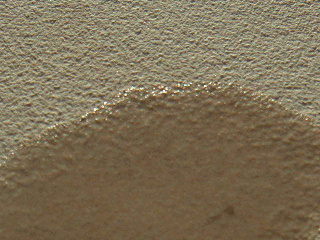
How to test for the surface absorption rate!
(This simple test will show you quite a bit about the true surface conditions.)
- Determine if that new surfacing has different characteristics than expected.
- Determine if a sealer (or oil, or wax) has been used, and how much is remaining below the surface.
- Determine absorption range to enable good decision making regarding the desired sealer's solids level. This will make sense in a few minutes as you proceed.
Using an eye dropper or drinking straw - randomly apply water drops to a few of the surface pieces. Don't forget to include the grout joints in your considerations. You will be looking for the surface to darken to some degree as an indication of water absorption.
This guideline of approximate rates refers to absorption of 90% or more of a water drop within the time stated. Below are videos that give an approximation of what you will see.
If the surface:
- Absorbs in 2 seconds or less ..... absorption is high
- Absorbs in 3 to 15 seconds ....... absorption is medium
- Absorbs in 16 to 60 seconds ...... absorption is low
- Absorbs in 1 to 3 minutes .......... absorption is very low
- Does not absorb in 15 minutes .. caution. This may be difficult to seal.
- Absorbs at noticably different rates in various places.
There may be something in the surface to impede sealer penetration, or it may have been sealed before without your knowledge. That sealing could have been done by the surfacing manufacturer, the selling store, or by the installer. This situation needs to be handled differently click here
Your surfacing will probably be somewhere in between these high and low examples. These video files are large and will take a minute to download, even on broadband connections.
|
absorption: Immediate darkening Rapid penetration |

This is a typical sandstone.
|
|
absorption: No darkening Very slow penetration Water bead retains a high, rounded shape |

This is raw, unsealed sandstone from Thailand. It has all the appearance of a high absorption stone, but surprisingly is very low absorption. This is a perfect example of why you should not believe anything about a surface type until you test. |